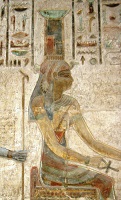 Nephthys was a goddess, whose name (Nebet hut in Egyptian) means "Lady of the House", in which "house" refers to the temple; unfortunately, it is not quite clear what temple is meant.
Nephthys was a goddess, whose name (Nebet hut in Egyptian) means "Lady of the House", in which "house" refers to the temple; unfortunately, it is not quite clear what temple is meant.
Nephthys has often been called a rather colourless goddess, due to the facts that her functions are considered to be somewhat vague and that not much is said to be known about a cult centre for her. However, recent research has painted a rather different picture.
It has been suggested in the past that her main function was only to complement Isis, due to the Egyptian preference for pairs. Indeed many goddesses seem to have been just a female counterpart, like the goddesses that belonged to the Ogdoad of Hermopolis (Hauhet, Naunet, Kauket and Amaunet, paired with Heh, Nun, Kek and Amun, gods whose function is much clearer). In the same way Tefnut was the counterpart of Shu.
At first sight the role of Nephthys wasn’t quite different. She could indeed often be seen together with Isis, usually while present in the judgement of the dead scene in the Book of the Dead, while personifying the two pylon towers of temples, and especially while sitting beside the body of Osiris as wailing women or as birds (being kites or falcons that produced piercing cries, reminding of the lamenting sounds produced by wailing women); sometimes they were women with outstretched wings, which stressed the protection they gave. But although the presence of Isis, directly involved as the wife of Osiris, can be easily explained in many such scenes, this does not imply that Nephthys was actually redundant or just added for the sake of having a pair.
On the contrary, she could be present as the opposite of Isis, like two antipodes who together, and only together, through their union, represented the full reality and who were both needed; polar opposites that were inseparable, that may seem incompatible but were mere aspects of the same reality, like life and death, light and dark, like for example Seth who was not only evil (murderer of Osiris) but also good (helper of Re, companion of the wife of Osiris).
Besides, the functions of Nephthys are becoming more and more clear also. She was a protective goddess, who could annihilate the enemies of the king with her breath, like the uraeus and goddesses identified with this cobra could do. She would also protect the temple. Nephthys was also considered to be the nurse of the king, giving him life and feeding him with milk like it is being done, in coronation scenes, by Wadjet, the cobra goddess. Well known is her role as the goddess protecting Hapy, one of the children of Horus, who was in charge of the lungs of the deceased after mummification. Also within funerary context Nephthys, again together with Isis, would sing lamentations for Osiris during an annual celebration performed in Abydos; two priestesses would play the roles of the two goddesses during this ritual.
Regarding the worship of Nephthys it is often stated that not much is known of her cult, but this simply isn’t accurate any more. Several temples for Nephthys are known from the Ramesside period. Nephthys was associated with Anuket in the Late Period; a temple for both existed in southern Egypt. There was also a cult for Nephthys at Tjebu (Greek Antaeopolis, modern Qaw el Kebir), and in Edfu there was a special festival for Nephthys. Nephthys was also associated with lion goddesses like Sekhmet and Mehyt; one of the chapels in Edfu temple is dedicated to Nephthys, Mehyt and Nekhbet. Also the names of several priests of Nephthys are known to us.
Nephthys was the daughter of Geb and Nut and the sister of Osiris, Isis and Seth. Sometimes she is described as the companion of Seth, but much of this tradition comes through Plutarch; it is certain however that Seth and Nephthys were worshipped together in the western oases during the last centuries of the ancient Egyptian culture. In some late and not always clear texts Nephthys is called the mother of Anubis, but some traditions mention Osiris as the father of Anubis whereas others say that Re was the father.
Nephthys was usually depicted as a woman wearing the hieroglyphs of her name in her head: the house or temple sign (hut) with a basket (neb) on top of it.
